- Joined
- Sep 7, 2007
- Messages
- 2,125
First off, I'd like to point out that this should be made a sticky if possible. A lot of you have asked me to do this and I finally got it done, sorry for the wait! 
Testudo hermanni hermanni from Different Localities:
As tortoise keeping/breeding and even conservation efforts have reached an all time high, many of the world's enthusiasts have come to learn much more about these animals, including variations in both species and subspecies. The proper identification of Hermann's tortoises (Testudo hermanni) has now been covered several times by both myself and others, but it is now clear to all of us that variation exists even within subspecies. The Western Hermann's or Italian tortoise (T. h. hermanni) is found in Italy including Sicily and Sardinia, the south of France (Var) as well as Corsica and Spain (the Balearic islands). While tortoises belonging to all of these localities do fall into the same category assigning them to the western subspecies, they do in fact vary in size, markings and overall coloration. As already stated in literature, in due time we may come to accept that there are more than just three subspecies of Hermann's tortoise. For now, these Italian, French and Spanish tortoises are accepted as the Western Hermann's tortoise.
After spending the last better part of a decade working with a large number of T. h. hermanni from different origins, I decided to make this thread and dedicate it to helping others gain somewhat of an idea on what they look like from each locality.
Before I get started, please keep in mind the following points:
1-I am NOT an expert but simply a passionate enthusiast with a lot of experience.
2-As nature will always allow, there is a great deal of variation even within one locality and there is an exception to every rule, therefore I can only point out what I have learned and what the "typical" traits are for each locality.
Testudo hermanni hermanni *ITALY*
The Western Hermann's tortoise is found throughout Italy as well as the islands of Sicily and Sardinia. On the Italian mainland, variation does occur in that specimens deriving from certain areas are darker while others may be lighter in overall coloration. The smallest of all T. h. hermanni are said to exist in Calabria, while the largest come from Sardinia. Tortoises with the most contrast are believed to derive from Puglia and Tuscan tortoises may be quite yellow. Having worked with tortoises from both Puglia and Sardinia, I will point out what I have come to learn.
Puglia, Italy
Tortoises from Puglia are know for sharp contrast on the carapace with thick black markings bordering a bright, golden yellow ground color. They are also smallish in size and very round with males exhibiting much less of a trapezoidal shape then say other male Hermann's tortoises. The head featuresa grey to light colored skin with yellow and light green areas around the back of the head and neck and the color of the nails matches that of the forelimbs, which can be very yellow. Five nails on each forelimb are usually present but four nails are not uncommon and even a combination of five nails on one foot and four on the other are seen as well. The bright yellow cheek patch found just behind and under each eye is very prominent in Puglian tortoises and even in very old specimens. The carapace is quite domed with the highest point clearly situated towards the front and the keyhole symbol on the fifth vertebral scute is typically thinner and may not be as clearly defined as in others, possibly due to the amount of intense black on the carapace. Males of this locality tend to max out at usually 4" and not more than 4.5" while females may reach 5" and occasionally 6". Average weight for males is between 300 and 400 grams while females may be between 600 and 950 grams.
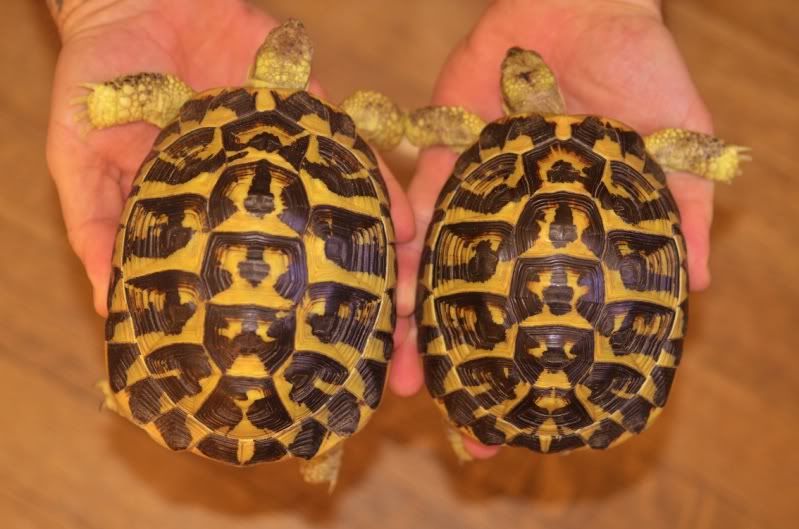
Two adult females, showing the very sharp contrast, round and smaller size, and green to yellow markings of the head.

Same two females showing the plastron.
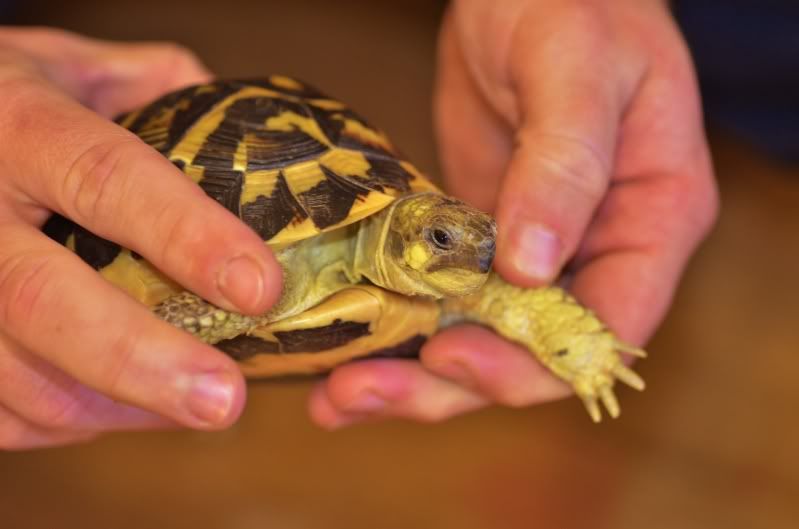
In this photo, the bright yellow cheek patch is clearly visible, as is the light colored nails on the forelimbs.
Sardinia, Italy
These tortoises are said to be the largest of those belonging to the Western subspecies with females surpassing 6 and 7" and weights of over 1,200 grams for both sexes. Sardinian tortoises also have contrasting black markings on the carapace like their Puglian neighbors, but feature less of it most of the time. The keyhole is more defined and wider, the carapace is broader and less domed and the highest point of it can be more towards the middle. The plastral banding is usually intense but certain specimens may exhibit less of it. On the gular scutes just under the neck, one or two black flecks are often present but not always. This is a trait also found in Corsican tortoises in France. The nails of Sardinians are usually black or dulled, the head is dark with a bright yellow cheek patch, is very snake-like and sleek.
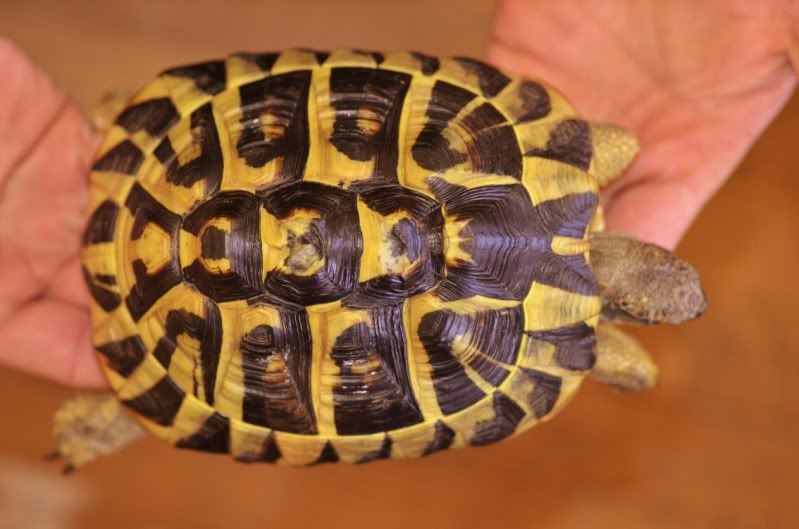
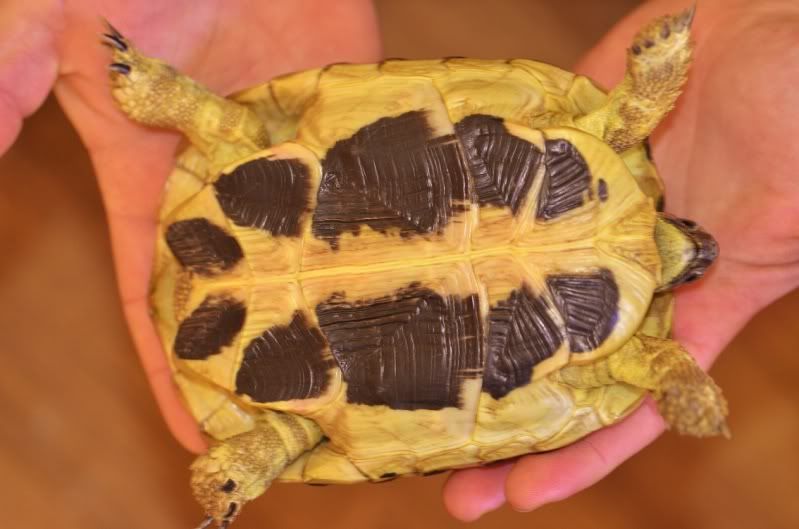
An adult female who is not done growing showing the classic markings, a darker head and a wider keyhole symbol.

Another adult female. This photo shows the dark head, dark nails and prominent cheek patch.
Testudo hermanni hermanni *SPAIN*
The T. h. hermanni of the Balearic islands are all very, very closely matched in size and color, with only a few small differences from island to island. Having worked with tortoises from Mallorca, it is with great confidence that I am able to point out the clear differences that set them apart from Italian tortoises.
Mallorca, Spain
Think yellow. These smaller tortoises are equipped with a bright, lemon yellow ground color on the carapace with black borders and blotches. The shape of the carapace is slightly more oblong than Puglian specimens but the highest point is still situated more towards the front or middle. The keyhole symbol varies depending on the amount of black coloration on the carapace but is typically much wider than that of Puglian tortoises. The plastral bands are very uniform and are almost always lacking on the gular scutes. The head is broader and is dark, sometimes black. The eyes sit high, and the yellow cheek patch may or may not be present. The color of the limbs is yellow and five black nails are present on each front foot. They are roughly the same size and weight of Puglian tortoises, but may be even smaller.
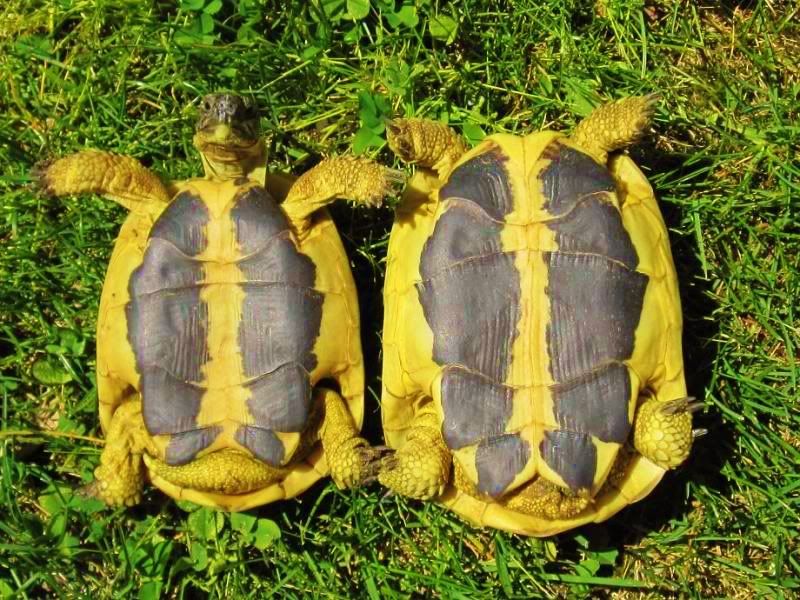
A Mallorcan pair showing the uniform bands and black nails of the forelimbs.

The lemon yellow coloration of the carapace and dark head color.
Testudo hermanni hermanni *FRANCE*
Western Hermann's tortoises are now only found in the south of France (vicinity of Var) and on the island of Corsica.
Corsica, France
Corsican tortoises are large much like the Sardinian animals but may be a bit smaller. They also exhibit more yellow with a "frayed" look to the carapace in contrast to the black markings and are usually flatter. The keyhole is usually quite large and prominent. The head is sleek with a bright yellow cheek patch and skin color is light with light colored nails. Underneath the neck on the gular scutes, one or two black flecks or stripes are usually present as in Sardinian animals. This locality of tortoise is known to have only four nails on each front foot and the 2nd vertebral scute is supposed to "dip" down into the 1st vertebral taking on the appearance of a "U" and not a square. Females have been known to surpass 7" and weigh 1,200 grams or more.
Varoise, France
T. h. hermanni, Var form, have more of a unique orange-yellow ground color on the carapace. The black markings are very prominent and the keyhole is well defined on the fifth vertebral scute. The overall shape is oblong or oval and not quite so round as in Puglian specimens. The head is very dark and the cheek patch is not always visible. The nails are typically black and five are present on each foot unlike the four that are found in Corsican specimens. The 2nd vertebral scute is straight edged and does not "dip" down as in Corse animals. The gular scutes are free of any markings. Size is around 5-5.5" for males and 6-6.5" for females.
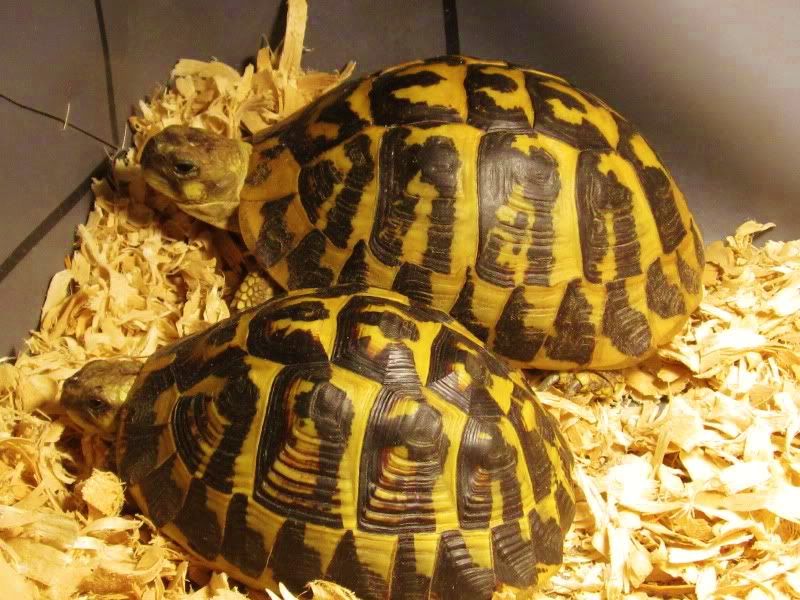
Together just for the photo, a Puglian animal in the foreground and a Varoise specimen in the background. Note the differences in shape, size and markings, these are both adults.
The Var tortoise is larger, longer, and has a more orange-yellow ground color. Both of these tortoises are adults.
Unfortunately it is impossible for me to post photos of tortoises from every single locality at this time but in Spring 2012 I will be able to allow everyone to view Corsican tortoises. This thread is a generalization of the variation that occurs in T. h. hermanni from different and specific localities and it is based on both what I have been taught, what I have read and mainly, my own personal experience in caring for these remarkable animals. The details I have described for each origin of tortoise are not "set in stone" per se, but are just additional information aimed at the growing interest in geographical variation of these creatures. I hope it helps anyone who is interested and trying to learn more about these rare tortoises.
Testudo hermanni hermanni from Different Localities:
As tortoise keeping/breeding and even conservation efforts have reached an all time high, many of the world's enthusiasts have come to learn much more about these animals, including variations in both species and subspecies. The proper identification of Hermann's tortoises (Testudo hermanni) has now been covered several times by both myself and others, but it is now clear to all of us that variation exists even within subspecies. The Western Hermann's or Italian tortoise (T. h. hermanni) is found in Italy including Sicily and Sardinia, the south of France (Var) as well as Corsica and Spain (the Balearic islands). While tortoises belonging to all of these localities do fall into the same category assigning them to the western subspecies, they do in fact vary in size, markings and overall coloration. As already stated in literature, in due time we may come to accept that there are more than just three subspecies of Hermann's tortoise. For now, these Italian, French and Spanish tortoises are accepted as the Western Hermann's tortoise.
After spending the last better part of a decade working with a large number of T. h. hermanni from different origins, I decided to make this thread and dedicate it to helping others gain somewhat of an idea on what they look like from each locality.
Before I get started, please keep in mind the following points:
1-I am NOT an expert but simply a passionate enthusiast with a lot of experience.
2-As nature will always allow, there is a great deal of variation even within one locality and there is an exception to every rule, therefore I can only point out what I have learned and what the "typical" traits are for each locality.
Testudo hermanni hermanni *ITALY*
The Western Hermann's tortoise is found throughout Italy as well as the islands of Sicily and Sardinia. On the Italian mainland, variation does occur in that specimens deriving from certain areas are darker while others may be lighter in overall coloration. The smallest of all T. h. hermanni are said to exist in Calabria, while the largest come from Sardinia. Tortoises with the most contrast are believed to derive from Puglia and Tuscan tortoises may be quite yellow. Having worked with tortoises from both Puglia and Sardinia, I will point out what I have come to learn.
Puglia, Italy
Tortoises from Puglia are know for sharp contrast on the carapace with thick black markings bordering a bright, golden yellow ground color. They are also smallish in size and very round with males exhibiting much less of a trapezoidal shape then say other male Hermann's tortoises. The head featuresa grey to light colored skin with yellow and light green areas around the back of the head and neck and the color of the nails matches that of the forelimbs, which can be very yellow. Five nails on each forelimb are usually present but four nails are not uncommon and even a combination of five nails on one foot and four on the other are seen as well. The bright yellow cheek patch found just behind and under each eye is very prominent in Puglian tortoises and even in very old specimens. The carapace is quite domed with the highest point clearly situated towards the front and the keyhole symbol on the fifth vertebral scute is typically thinner and may not be as clearly defined as in others, possibly due to the amount of intense black on the carapace. Males of this locality tend to max out at usually 4" and not more than 4.5" while females may reach 5" and occasionally 6". Average weight for males is between 300 and 400 grams while females may be between 600 and 950 grams.

Two adult females, showing the very sharp contrast, round and smaller size, and green to yellow markings of the head.

Same two females showing the plastron.

In this photo, the bright yellow cheek patch is clearly visible, as is the light colored nails on the forelimbs.
Sardinia, Italy
These tortoises are said to be the largest of those belonging to the Western subspecies with females surpassing 6 and 7" and weights of over 1,200 grams for both sexes. Sardinian tortoises also have contrasting black markings on the carapace like their Puglian neighbors, but feature less of it most of the time. The keyhole is more defined and wider, the carapace is broader and less domed and the highest point of it can be more towards the middle. The plastral banding is usually intense but certain specimens may exhibit less of it. On the gular scutes just under the neck, one or two black flecks are often present but not always. This is a trait also found in Corsican tortoises in France. The nails of Sardinians are usually black or dulled, the head is dark with a bright yellow cheek patch, is very snake-like and sleek.


An adult female who is not done growing showing the classic markings, a darker head and a wider keyhole symbol.

Another adult female. This photo shows the dark head, dark nails and prominent cheek patch.
Testudo hermanni hermanni *SPAIN*
The T. h. hermanni of the Balearic islands are all very, very closely matched in size and color, with only a few small differences from island to island. Having worked with tortoises from Mallorca, it is with great confidence that I am able to point out the clear differences that set them apart from Italian tortoises.
Mallorca, Spain
Think yellow. These smaller tortoises are equipped with a bright, lemon yellow ground color on the carapace with black borders and blotches. The shape of the carapace is slightly more oblong than Puglian specimens but the highest point is still situated more towards the front or middle. The keyhole symbol varies depending on the amount of black coloration on the carapace but is typically much wider than that of Puglian tortoises. The plastral bands are very uniform and are almost always lacking on the gular scutes. The head is broader and is dark, sometimes black. The eyes sit high, and the yellow cheek patch may or may not be present. The color of the limbs is yellow and five black nails are present on each front foot. They are roughly the same size and weight of Puglian tortoises, but may be even smaller.

A Mallorcan pair showing the uniform bands and black nails of the forelimbs.

The lemon yellow coloration of the carapace and dark head color.
Testudo hermanni hermanni *FRANCE*
Western Hermann's tortoises are now only found in the south of France (vicinity of Var) and on the island of Corsica.
Corsica, France
Corsican tortoises are large much like the Sardinian animals but may be a bit smaller. They also exhibit more yellow with a "frayed" look to the carapace in contrast to the black markings and are usually flatter. The keyhole is usually quite large and prominent. The head is sleek with a bright yellow cheek patch and skin color is light with light colored nails. Underneath the neck on the gular scutes, one or two black flecks or stripes are usually present as in Sardinian animals. This locality of tortoise is known to have only four nails on each front foot and the 2nd vertebral scute is supposed to "dip" down into the 1st vertebral taking on the appearance of a "U" and not a square. Females have been known to surpass 7" and weigh 1,200 grams or more.
Varoise, France
T. h. hermanni, Var form, have more of a unique orange-yellow ground color on the carapace. The black markings are very prominent and the keyhole is well defined on the fifth vertebral scute. The overall shape is oblong or oval and not quite so round as in Puglian specimens. The head is very dark and the cheek patch is not always visible. The nails are typically black and five are present on each foot unlike the four that are found in Corsican specimens. The 2nd vertebral scute is straight edged and does not "dip" down as in Corse animals. The gular scutes are free of any markings. Size is around 5-5.5" for males and 6-6.5" for females.

Together just for the photo, a Puglian animal in the foreground and a Varoise specimen in the background. Note the differences in shape, size and markings, these are both adults.
The Var tortoise is larger, longer, and has a more orange-yellow ground color. Both of these tortoises are adults.
Unfortunately it is impossible for me to post photos of tortoises from every single locality at this time but in Spring 2012 I will be able to allow everyone to view Corsican tortoises. This thread is a generalization of the variation that occurs in T. h. hermanni from different and specific localities and it is based on both what I have been taught, what I have read and mainly, my own personal experience in caring for these remarkable animals. The details I have described for each origin of tortoise are not "set in stone" per se, but are just additional information aimed at the growing interest in geographical variation of these creatures. I hope it helps anyone who is interested and trying to learn more about these rare tortoises.